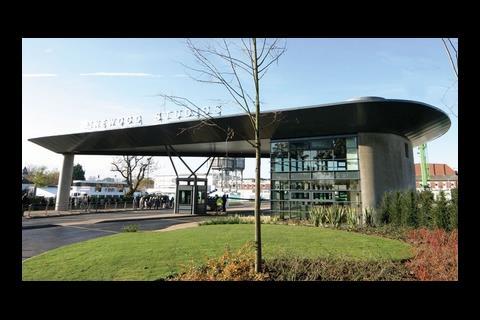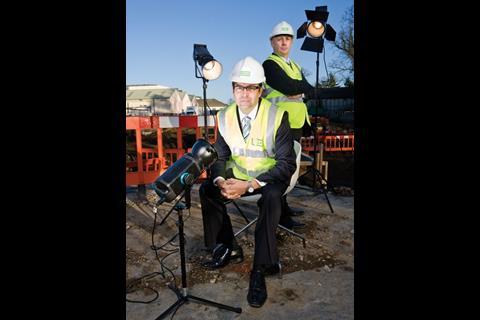Okay, so this is the story: two guys called Adams and Wilde dream of setting up their own business. Only the firm called Benson theyŌĆÖre working for goes bust and our two heroes have to work under a new regime they canŌĆÖt stand. So what do they do? They get the hell out, set up their own business and get all the good guys from Benson to work for it. So, Daniel Craig and Clive Owen for the lead roles?
As Ken Adams and Mike Wilde watch from the wings at Pinewood Studios as work starts on their most valuable project to date, the two former directors of bust fit-out contractor Benson are entitled to a momentŌĆÖs reflection on their three-year rollercoaster ride.
ŌĆ£Ninety-nine per cent of the time you donŌĆÖt give it a thought,ŌĆØ says Wilde. ŌĆ£But there are occasions, like when the site board goes up on something like this, that you think, hell, thatŌĆÖs us.ŌĆØ
WildeŌĆÖs pride is easy to understand. Lifebuild, the start-up contractor which he and Adams established from scratch in 2005, has just won a ┬Ż6m deal from Pinewood and Technicolor, silver screen pioneers and the makers of the Bond movies. The firm will build film laboratories at the studios where Connery & Co made their name. The deal is the largest in LifebuildŌĆÖs short history and its first true glamour project.
ItŌĆÖs a far cry from the bleak, uncertain future facing the pair this time three years ago. In mid December 2004, Adams and Wilde ŌĆō then young, dynamic directors of BensonŌĆÖs Northern Home Counties division ŌĆō found out that the profitable, ┬Ż25m turnover regional business theyŌĆÖd built from nothing was about to be lost. Loss-making contracts and poor management in BensonŌĆÖs Midlands division had, unknown to managers elsewhere, been dragging the entire business down for months. Now the secret was out and Benson was about to be plunged into administration.
The Benson years
It was the ambition to run his own business that pushed Adams to join Benson in 2001. Both he and Wilde had worked for Bickerton in St Albans in the years before its troubled sale to Artisan. The Bickerton board had decided to float the company, and Adams, a shareholding director, was concerned about the constraints a PLC would bring. He started looking for a way out.
Then a call came from Alistair Sloan, managing director of Benson. He convinced Adams to join. The clincher? Adams was to run his own division in the Northern Home Counties (NHC) as a start-up.
One of the first people he called was Mike Wilde, already working in the area as a regional MD for Bickerton. Wilde jumped at the chance to join the charismatic Adams as construction director, and so began a wave of Bickerton ship-jumping.
ŌĆ£We started off with no jobs and no staff,ŌĆØ says Adams. ŌĆ£But we were very lucky in that we had good people at Bickerton who were very unhappy. We didnŌĆÖt need to use any recruitment agencies.ŌĆØ
Benson, a ┬Ż170m turnover business, offered IT and payroll support to the region, but left them to do everything else themselves. Despite this, in four years Adams and Wilde took the business from nothing to a ┬Ż25m order book, earning it a reputation as the most successful part of the overall company.
ŌĆ£Those were four of the best years of my career,ŌĆØ says Wilde. ŌĆ£We were always on time and on budget, and clients always came back to us. It was the first time I had started something like that.ŌĆØ
But the good times ended abruptly.
The downfall
The fact that something was very wrong with Benson became apparent in August 2004. Adams and Wilde had to learn about it from the press: the Midlands business, struggling under loss-making contracts and a poor local reputation, had gone into receivership.
A further shock waited. Initially their division continued normally despite the travails in the Midlands. But as time went on and MidlandsŌĆÖ suppliers were left unpaid, attitudes towards the company as a whole began to change. ŌĆ£Clients began to lose confidence,ŌĆØ says Wilde. Adams puts it more bluntly: ŌĆ£The receivership was badly handled,ŌĆØ he says. ŌĆ£Subcontractors didnŌĆÖt understand why they werenŌĆÖt being paid when the parent company was still afloat.ŌĆØ
Then came the bombshell. Sloan departed suddenly amid rumours of a boardroom bust-up. ŌĆ£That was a shock to everyone,ŌĆØ says Adams. ŌĆ£He was a charismatic character. WeŌĆÖd had a good relationship.ŌĆØ
Within days the board decided to put the business into receivership. ŌĆ£It was just before Christmas,ŌĆØ says Adams. ŌĆ£It was our livelihoods now we were concerned for.ŌĆØ
Adams and Wilde decided to try and buy the NHC division. ŌĆ£I was frustrated,ŌĆØ says Adams. ŌĆ£I had built a great business and through no fault of ours other parts of the business were mismanaged.ŌĆØ He pauses. ŌĆ£But it was a case of the king is dead, long live the king.ŌĆØ
At Lifebuild we really did have nothing. I literally got on the phone and said to people, ŌĆśgive us a jobŌĆÖ
Ken Adams, Lifebuild
They made calls to try to get financial backing but, having been kept in the dark until the last minute, they were too late. Bluestone, a subsidiary of Morgan Sindall, had made an offer for the Southampton, NHC and New Reigate divisions.
ŌĆ£We ended up there [at Morgan Sindall] on the Friday night,ŌĆØ Adams recalls. ŌĆ£Morgan Sindall said they could secure jobs, and from then we were just seeing how we could work with them. Morgan Sindall wanted the three best parts of Benson together or no deal. Personally as well, I thought Bluestone could offer a lot, and my visions of buying a business were put to one side.ŌĆØ
Six weeks later Adams changed his mind dramatically. ŌĆ£It was a totally different style of management,ŌĆØ he says. ŌĆ£There was no freedom, no entrepreneurial spirit. And on top of that, no one knew who was running who.ŌĆØ
Adams acknowledges that things looked different from Morgan SindallŌĆÖs perspective. ŌĆ£There were subcontractor issues to deal with, and they just saw that Benson had failed,ŌĆØ he says. But his mind was made up: he was going to throw everything at setting up his own company. ŌĆ£It seemed so prescriptive at Morgan Sindall that for each of us, it confirmed that it was now or never.ŌĆØ
The birth of Lifebuild
Adams left and Wilde followed him weeks later. They set up their new company Lifebuild in AdamsŌĆÖ living room in Birkenhead on 22 February 2005.
Says Adams: ŌĆ£Mike and I had spoken a lot before about what it would be like running our own business, and so when it happened, it was almost overnight. Mike came over to my house and we just started.ŌĆØ
From day one, Adams started pushing old NHC contacts for business. ŌĆ£We really did have nothing. I literally got on the phone and said to people, ŌĆśgive us a jobŌĆÖ.ŌĆØ
LifebuildŌĆÖs first contract, with Adams as surveyor and Wilde as contract manager, was a ┬Ż150,000 office fit-out in the West End, won through a recommendation from architect Graham Seabrook. Seabrook persuaded the client to pay Lifebuild every two weeks, providing the pair, who had each taken a second mortgage, with badly needed cash.
Adams and Wilde had two other guardian angels. Ken Wilkins, the founder of Hatfield Construction who bought Bickerton when it was losing money, came out of retirement to offer financial backing to Lifebuild along with his long-term business partner, entrepreneur Bob Morton. Wilkins became a non-executive director, bringing his expertise to the firm. Their sheer physical presence also came in handy: ŌĆ£They added depth as well,ŌĆØ says Wilde wryly. ŌĆ£It looked a lot better than just us going to a meeting.ŌĆØ
For the first year, Wilde and Adams focused on creating a business plan, and drawing up a list of former colleagues ŌĆō now disillusioned with Bluestone ŌĆō they would attempt to bring on board. Problems with a ┬Ż1.5m contract on Northfield High School, which was held up because of a delay with lottery funding, meant the business remained in the living room.
But in the meantime, Lifebuild had tendered and won other smaller jobs, including construction of a ┬Ż750,000 house. The job needed to complete on 23 December for the client to move in and on 23 December Adams and Wilde were sat in the kitchen cheekily supping champagne. ŌĆ£It was a big moment for us,ŌĆØ says Wilde, ŌĆ£as we knew we could deliver.ŌĆØ
Coming of age
Now ensconced in permanent offices in High Wycombe and with a secured forward order book of ┬Ż10m to compare with last yearŌĆÖs ┬Ż3.5m, Adams and WildeŌĆÖs reincarnation is almost complete. Lifebuild now employs 17 staff, all but one of them ex-Benson NHC. They are on target to create their goal, a regional business of about a ┬Ż20m turnover.
ŌĆ£We could be in a stronger position this year than our business plan envisaged thanks to the Pinewood contract,ŌĆØ says Adams.
Current market conditions are not ideal for small businesses, but Lifebuild looks relatively well placed to weather the storm. Its market spread is fairly even, without huge exposure to either commercial or private housing but with a strong presence in education and social housing, sectors still receiving government spending.
Adams boasts that getting to ┬Ż20m wonŌĆÖt be the hard part: keeping it there will be. After Benson they are determined to keep a lid on the companyŌĆÖs growth. ŌĆ£┬Ż20m means weŌĆÖre in control,ŌĆØ says Adams firmly. ŌĆ£ThereŌĆÖs no point in having a business if you donŌĆÖt manage it properly.ŌĆØ
ŌĆ£Not growing too quickly, maintaining control,ŌĆØ adds Wilde. ŌĆ£ThatŌĆÖs the Benson lesson.ŌĆØ And after the strain of the past three years, itŌĆÖs easy to see why they wouldnŌĆÖt want a sequel.





























No comments yet